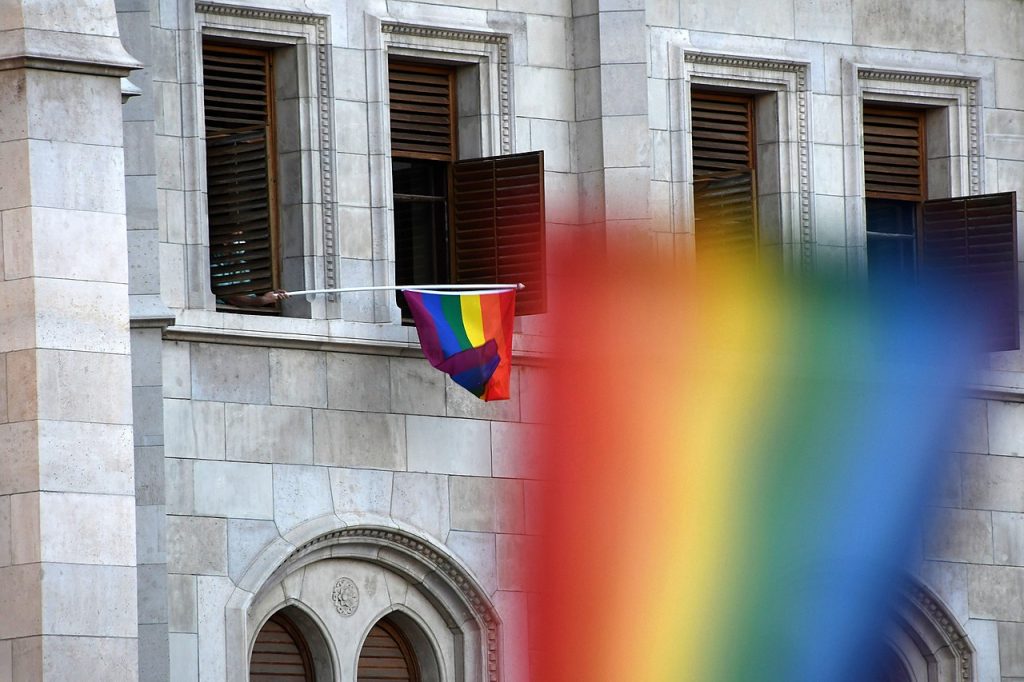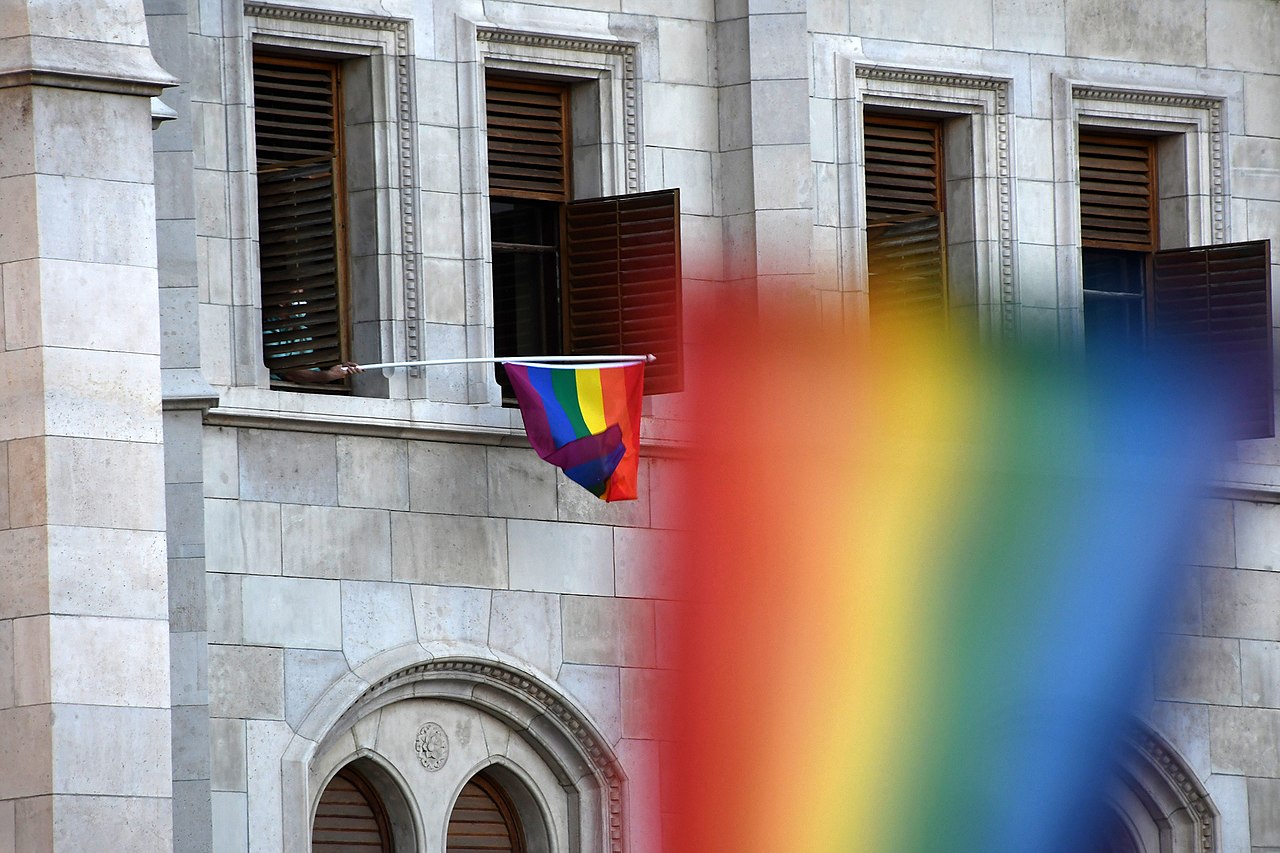On 18 March 2025, Hungary’s ongoing legislative assault on LGBTQ+ people escalated with a law that strikes at the heart of basic human rights and fundamental European values. The Hungarian parliament passed a bill that effectively bans Pride events, citing ‘child protection’ as its justification.
This was not merely another legal measure intended to discriminate against the LGBTQ+ population. It was also a performance of ideological control. A spectacle. A message. One that recast Pride from celebration to provocation, and queerness from identity to threat.
But on 16 June, in move unprecedented in its defiance of government pressure, Budapest’s mayor Gergely Karácsony announced that the city would officially co-organize Budapest Pride as a celebration of freedom, thereby circumventing the law that allows the police to ban LGTBQ+ marches.
This positions the capital as a symbolic and literal counterweight to Orbán’s legislative assault. By offering municipal backing, Karácsony affirms that Pride is not only a protest, but also a protected expression of civic freedom.

Image: Pasztilla aka Attila Terbócs / Source: Wikimedia Commons
This is but one victory in an ongoing struggle for LGBTQ+ freedoms in Hungary and across the across the region. For unfortunately, Hungary is no longer an anomaly in Europe. On the contrary, when it comes to persecuting LGBTQ+ people, the country has become a trendsetter.
From progress to persecution
It was by no means always this way. Homosexuality was decriminalized in Hungary as early as 1961, and although cultural conservatism persisted, legal reforms gradually caught up. Before Viktor Orbán’s Fidesz returned to power in 2010, Hungary had made steady, if cautious, progress toward LGBTQ+ equality and acceptance. In 2009, Hungary introduced registered partnerships for same-sex couples, a significant – if imperfect – step toward recognition and dignity.
But after 2010 and the pivot towards illiberalism, LGBTQ+ rights became collateral damage in Fidesz’s quest to ‘restore national values’. Although the shift was not immediate, ominous signs emerged early on. In 2012, the far-right party Jobbik introduced a bill seeking to ban the ‘promotion’ of homosexuality. The bill didn’t pass, but it was a warning shot. In retrospect, it looks less like an outlier and more like the opening line of a broader political script.
The real rupture came in 2020, when the Hungarian Parliament passed legislation banning the legal recognition of gender changes. Transgender and intersex people were stripped of the right to update their documents, locking them into misidentification and daily bureaucratic humiliation. From that moment on, transphobia was enshrined in law. The new legislation marked a chilling escalation: from hostile rhetoric to targeted, codified erasure.
Then came 2021, and with it the so-called ‘Child Protection Act’ – a law that nominally claimed to protect minors but in practice served to silence queerness. Modelled closely on Russia’s ‘gay propaganda’ law, the legislation banned the depiction or discussion of homosexuality and gender transition in content accessible to minors, whether via education, television, literature or other channels.
The framing was strategic: queerness wasn’t criminalized but cast as inappropriate, corrupting and dangerous for youth. Drawing on long-standing moral panic tactics, Fidesz equated LGBTQ+ visibility with grooming, sexual deviance and child endangerment. Passed swiftly and without meaningful public input, the law sparked protests and triggered infringement procedures by the European Union.
Later that year, an implementing decree extended the law’s logic into everyday cultural spaces – most notably, bookstores. From now on LGBTQ+ books had to be removed from youth sections, sold in non-transparent packaging, and kept out of shop windows or locations within 200 metres of a school or church.
These rules technically came into effect in 2021, but only began to bite in 2023, when enforcement was ramped up. In a widely publicized case, a major bookstore chain was fined for displaying the popular queer graphic novel Heartstopper without the closed, opaque wrapping prescribed by the law. The message was unambiguous: queer stories could still exist – but only out of sight and out of reach.
The transformation of LGBTQ+ identities into a perceived national threat is the result of a deliberate and sustained political strategy. One of the earliest signals came in 2019, when the Speaker of the National Assembly, László Kövér, compared same-sex marriages and adoption to paedophilia. This outrageous comment was not retracted even after being condemned by rights groups. Instead, it established a new rhetorical terrain where queerness is associated with harm, particularly to children. A year later, Viktor Orbán himself declared that ‘gays must leave our children alone’, drawing a so-called red line that blurred the distinction between identity and threat.
These and other statements weren’t offhand remarks but calculated moves in a broader discursive shift. In 2020, state-aligned outlets and official speeches began referring to LGBTQ+ rights as ‘gender propaganda’ or ‘foreign ideology’. The narrative crystallized: LGBTQ+ visibility was a form of liberal colonization – an external force being imposed on Hungary by global elites, EU bureaucrats, and ‘woke’ activists. Traditional families – whose definition obviously excludes non-heterosexual, non-cisgendered and non-nuclear families – were cast as the last bastion of national integrity.
The 2021 ‘Child Protection Act’ put these ideas into legal form, and the government doubled down. Referendums were launched to legitimize the crackdown; press releases framed the measures as necessary moral defences. Children became a rhetorical shield whose safety was invoked repeatedly to imply that queerness was not only inappropriate but predatory.
This shift was echoed by state-aligned media, where LGBTQ+ issues were treated not as civil rights questions but as ideological battlegrounds. Newspapers such as Magyar Nemzet and the television channel HírTV linked Pride to chaos, cultural decline, and moral confusion. The effect was cumulative: a slow poisoning of the discourse, in which queer people were stripped of complexity and portrayed as agents of decay. Gender theory was demonised in the process, to the detriment of women’s rights.
Symbolic violence thus became institutionalized – both through what laws say, and through what they imply. To be queer in Hungary today is to be treated not just as unequal, but also as unwanted. The message, repeated in policy and press alike, is that queerness is anti-Hungarian or ‘un-Hungarian’. Once that symbolic boundary has been drawn, exclusion is possible and indeed popular.
The making of the Other
Framed as a measure to safeguard morality, the law banning Pride is a direct attack on freedom of assembly and expression and marks a chilling milestone in the government’s campaign of exclusion.
The new legislation foresees a fine of up to 200,000 HUF (approximately €500) for individuals participating in Pride events and imprisonment for up to a year for organizers. The law also authorizes the Hungarian authorities to use facial recognition technology to identify participants, a move that has sparked significant privacy and human rights concerns.
This is more than legislation; it is a performance of power. The Pride ban is a communicative act – one that constructs and enforces boundaries around the national public space, defining who is permitted to be seen and speak in it. Together, with earlier laws, it forms a narrative architecture in which queerness is framed not just as deviant, but as incompatible with Hungarian identity and the safety of the nation. Queerness is not only erased from public space but reduced to a cultural contaminant – coded as inappropriate, threatening, or obscene. This is the language of euphemism, of moral panic, of symbolic violence without physical bruises.
The state relies on binary oppositions to secure this narrative: Hungarian versus foreign, Christian versus liberal, moral versus deviant. These oppositions aren’t just semantic tools. They are ideological weapons. Through them, the state draws a line, placing queer people on the wrong side of it, stripping them of moral value, cultural legitimacy, and symbolic citizenship. Queerness is cast as an ideological intrusion – imported, alien to Hungary’s cultural core.
Othering works by reducing people to caricatures, by transforming complex human lives into threats, spectacles, aliens or cautionary tales. In Hungary’s current discourse, to be queer is not only to be different, but to be wrong – unnatural, dangerous, contaminating.
Through this binary logic, LGBTQ+ people are positioned as everything Hungary is not supposed to be. The state thereby performs symbolic violence: a subtler but deeply damaging form of harm that works not through physical force, but cultural exclusion. It chips away at recognition, legitimacy, and belonging – legally, publicly and repeatedly casting queer existence as a moral threat. Since the right to amend one’s gender in legal documents was abolished, even existing in public is an act of defiance for many trans Hungarians – visibility itself becomes both risk and resistance.
When the state decides that queerness is not just outside the norm but against the nation, it licenses more than exclusion. Suspicion, hatred, even physical violence are also sanctioned. Pride is banned not because of what it is, but because of what it represents: an unapologetic claim to space, joy, dignity and belonging. And for a government invested in purity – of the nation, of values, of bodies – that is intolerable.
The state does not need to deny rights explicitly – it only needs to legislate queerness out of public life, out of visibility. A Pride march becomes a ‘morality risk’. A children’s book with two dads becomes contraband. Erasure becomes policy. The closet becomes law.
Regional homophobia
Hungary is not an outlier. Across central and eastern Europe, similar tactics are taking root. Though adjusted to local political realities, all follow the same ideological blueprint.
In Poland, the party Law and Justice (PiS) made LGBTQ+ rights a scapegoat in its culture war, with municipalities declaring themselves ‘LGBT-free zones’ and government officials describing queerness as a foreign ideology threatening the Polish family. Under the PiS government, Pride events in Poland were routinely obstructed or violently attacked, and queer activists subject to surveillance and harassment. Although PiS was replaced as the party of government at the end of 2023, the anti-LGTBQ+ rhetoric remains. The president elect, Karol Nawrocki, is a conservative who supports close ties between the government and the Catholic Church and is a rigid opponent of same-sex marriage.
In June 2020, the Romanian parliament passed a law amending the National Education Law to prohibit activities aimed at ‘spreading theories or opinions on gender identity’. Human rights organizations, academics, and students pushed back against the law, which effectively bans discussions on gender identity in educational settings, calling it a violation of fundamental rights and an attack on academic freedom. In December 2020, the Romanian Constitutional Court struck down the ban – but only after months of political debate framing ‘gender ideology’ as a western import eroding national values.
These examples are not identical, but they rhyme. They speak to a broader regional strategy: the use of queerness as a symbolic enemy, a stand-in for all that is foreign, destabilizing, and morally suspect. It is a strategy rooted in othering, legitimized through the language of sovereignty, family, and child protection, and executed through legal restrictions, censorship, and cultural vilification.
Clearly, what is happening in Hungary is not an isolated case. Rather, it is part of a slow but steady regional realignment – a roll-back not just of rights, but of recognition itself; recognition not just of dignity or citizenship, but of humanity. When queerness is framed not simply as alien but as actively threatening – to the nation, to cultural identity, to family values, to the wellbeing of children – it creates fertile ground for further harm. What begins with erasure of visibility can quickly become permission for the violation of bodies. Symbolic exclusion makes physical violence easier to justify.
In 2022, two queer people were murdered outside a gay bar in Bratislava, Slovakia. The government condemned the violence – but many of the same officials had previously trafficked in the anti-LGBTQ+ rhetoric that helped enable it. Symbolic violence is never just symbolic. What begins with the erasure of visibility quickly becomes the justification for real-world violation. And what is banned from public space can, in time, be banished from life itself.
For many queer people in the region, this climate doesn’t just threaten their rights – it erodes their sense of safety, dignity and future. What does it mean to come of age under a government that denies your existence? To have your body politicized before you even know its name?
It means navigating adolescence with shame stitched into your citizenship. It means learning early that desire, when misaligned with the state, can make you a criminal, even before you’ve kissed anyone at all.
Symbolic resistance
Still, even under erasure, resistance speaks. LGBTQ+ organizers in Hungary have answered the state’s communicative and legislative acts of violence with symbols of their own. The 2025 Budapest Pride theme, We are (home), asserts what the government denies: that queer people are not outsiders, but citizens, woven into the fabric of Hungarian life. Pride’s revival of the revolutionary slogan Éljen a magyar szabadság! (‘Long live Hungarian freedom!’) reclaims nationalism from the far-right, merging queer resistance with the language of national pride.
These gestures may seem symbolic – but when visibility itself is criminalized, symbolism becomes survival. What the state tries to silence, Pride declares in the nation’s own tongue: we exist, and we belong.
The symbolic defiance of Budapest Pride is not new. One of the oldest Pride movements in Central Europe, its organizers have long understood that visibility is never neutral. In a country where queerness is legislated out of classrooms and bookstores, showing up – with flags, slogans, each other – becomes an act of radical presence. In the face of rising authoritarianism, even joy becomes a political act. Online campaigns, international solidarity posts and queer mutual aid projects now form a decentralized network of resistance, one that the state struggles to contain.
What is happening in Hungary and other CEE states is a concentrated version of what is simmering across much of the world. From Florida’s classroom bans to Russia’s anti-LGBTQ+ laws, the script Hungary follows is no longer local – it’s global, and it’s being copied. The criminalization of visibility, the rhetorical reshaping of queerness into deviance, the slow drift from symbolic exclusion to institutional erasure – these are not isolated moves, but rehearsed strategies. A pattern.
And yet, queer resistance endures. In 2025, Budapest Pride responded not with confrontation, but with symbolic jiu-jitsu: flipping the government’s nationalist imagery back on itself, claiming the flag, the history, the language of freedom.
In many western countries, gender diversity is selectively embraced as branding, as marketing strategies, or as a corporate performance. But in Hungary, diversity is not mismanaged but being actively dismantled. The state is not stumbling on its path of creating a more equitable society. It is choosing to regress.
Yet, despite censorship, surveillance, and silence, LGBTQ+ Hungarians continue to exist, resist, and reimagine what it means to belong. Their protest is not only political – it is a communicative act and it is symbolic pushback. A refusal to vanish and be erased: a declaration of presence.
In the end, visibility is not just a right. It is a battleground.
We are (home). We are still here. And we are not leaving.







